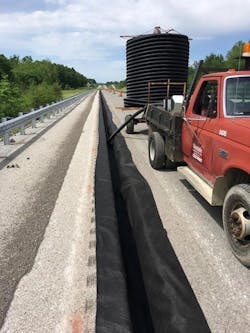About the author:
Steve Cooper is a writer for SCA Communications. Cooper can be reached at [email protected].
by Steve Cooper
undefinedA storm water system update was needed when changing a road from a local parkway to a federal highway.
When William H. Natcher Parkway became I-165, more was needed than just widening the road – a completely new edge drain that ran for nearly 90 miles was required to control storm water runoff and meet federal highway requirements.
The I-165 corridor requires reconstructing three cloverleaf interchanges designed to accommodate drivers who were slowing and stopping at toll plazas – as opposed to merging with or exiting from 70 mph interstate traffic.
Work is also occurring on the parkway in Bowling Green. The entire 72-mile stretch between Bowling Green and Owensboro will become I-165 within the next five to ten years. Converting the Natcher Parkway into an Interstate 65 spur was undertaken as a way to improve economic development opportunities for the region. The improvements and upgrades will meet the federal guidelines for interstate standards by extending the ramp tapers making it safer for drivers to exit on and off the interstate as well as upgrading the bridge walls and bridge decks. It is part of Kentucky’s 2018 to 2024 Highway Plan that includes $8.5 billion for more than 1,400 projects, such as bridge and pavement improvements, road widening, reconstruction of existing roads and new routes and interchanges.
The total amount of drainage pipe used was more than 472,000 feet of Advanced Drainage Systems 4-inch diameter, perforated single wall N-12 corrugated high-density polyethylene (HDPE) pipe and the same amount of ADS 0701T 6-foot wide geosynthetic fabric. The $28 million road project, which ranged from Bowling Green to Owensboro, was accomplished by contractor Westate Construction of Hopkinsville, Kentucky, from March 2019 to July 2019. Because the pipe came in 3,200-foot rolls and the fabric was also easy to put down in the trench and wrap around the pipe, the job was completed on time. It was typical for the Westate crew to install 9,000 to 12,000 feet in a day.
The trench is lined with a needle-punched nonwoven geotextile made of 100% polypropylene staple fibers, which are formed into a random network for dimensional stability. It resists ultraviolet deterioration, rotting, biological degradation, naturally encountered basics and acids. Polypropylene is stable within a pH range of 2 to 13. The HDPE perforated pipe is then laid in the trench.
For years, highway base drainage methods have included free-draining bases, french drains, pipe and aggregate subdrains and geocomposite edge drains. The growing importance of drainage has been driven by the design of the interstate highway system with dense, relatively impervious base-course materials and limited underdrain design. The trapping of water between the pavement and base has led to drastically shortened highway life. The basic design of the drainage system is intended to improve the rate of the introduction of free water by increasing the surface area in contact with the base-course material and by placing the product in intimate contact with the pavement edge and the base-pavement interface.
Longitudinal edge drains have been used in Kentucky and around the country for some 35 years. Most were installed on the interstate and parkway systems. Currently, there are hundreds of lane-miles in place in Kentucky. The first edge drains consisted of 4-inch perforated polyethylene pipe installed in a 12-inch-wide trench. It has been found that HDPE perforated drain pipe enveloped in a geotextile wrap provides ease of installation due to the long, continuous lengths of the pipe, narrow trench widths and provides a rapid response time for water to enter the system.






